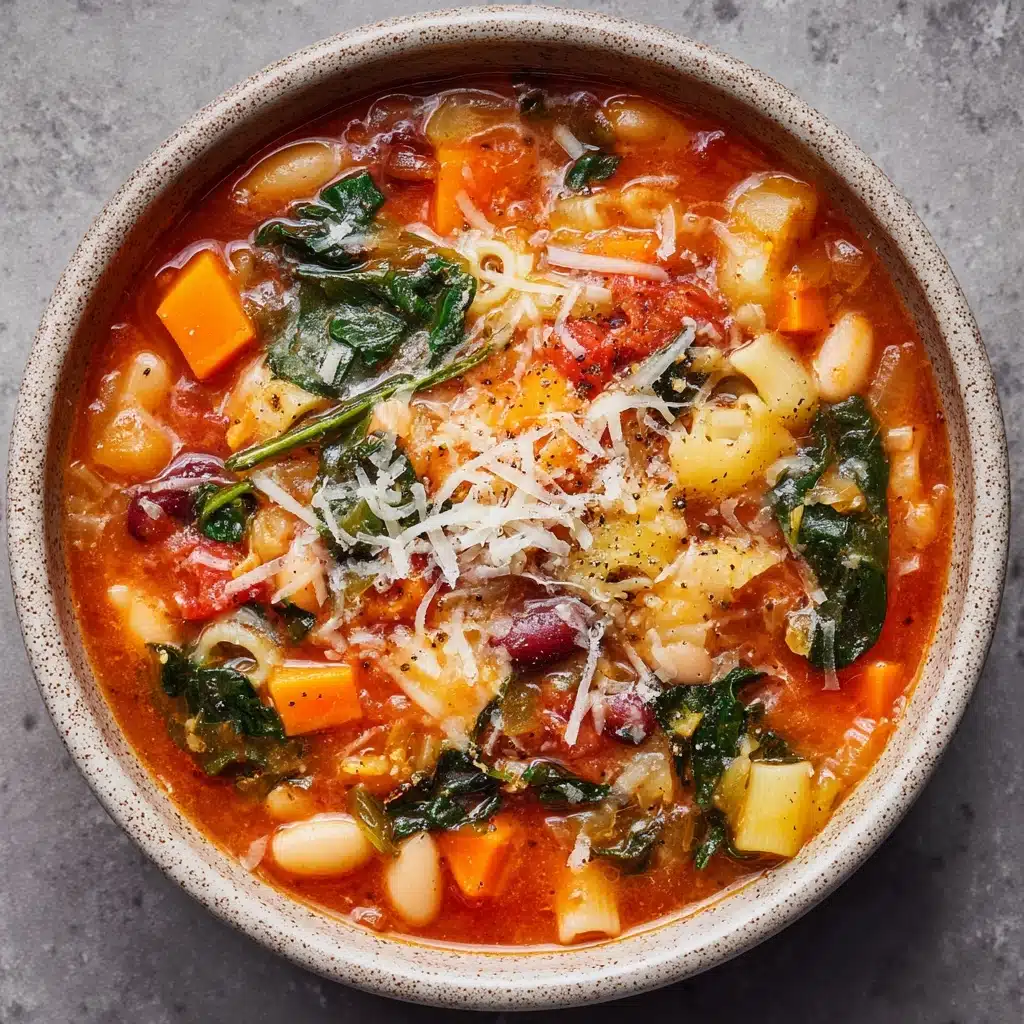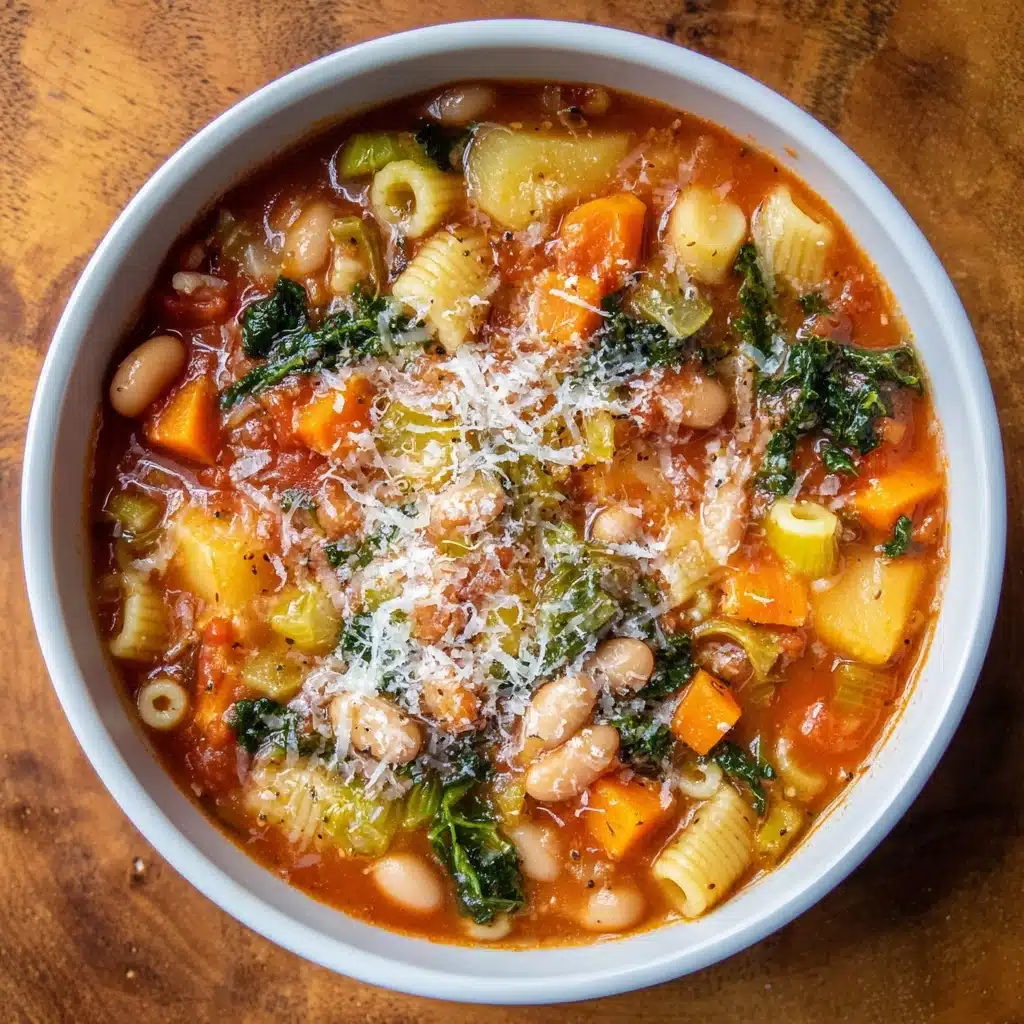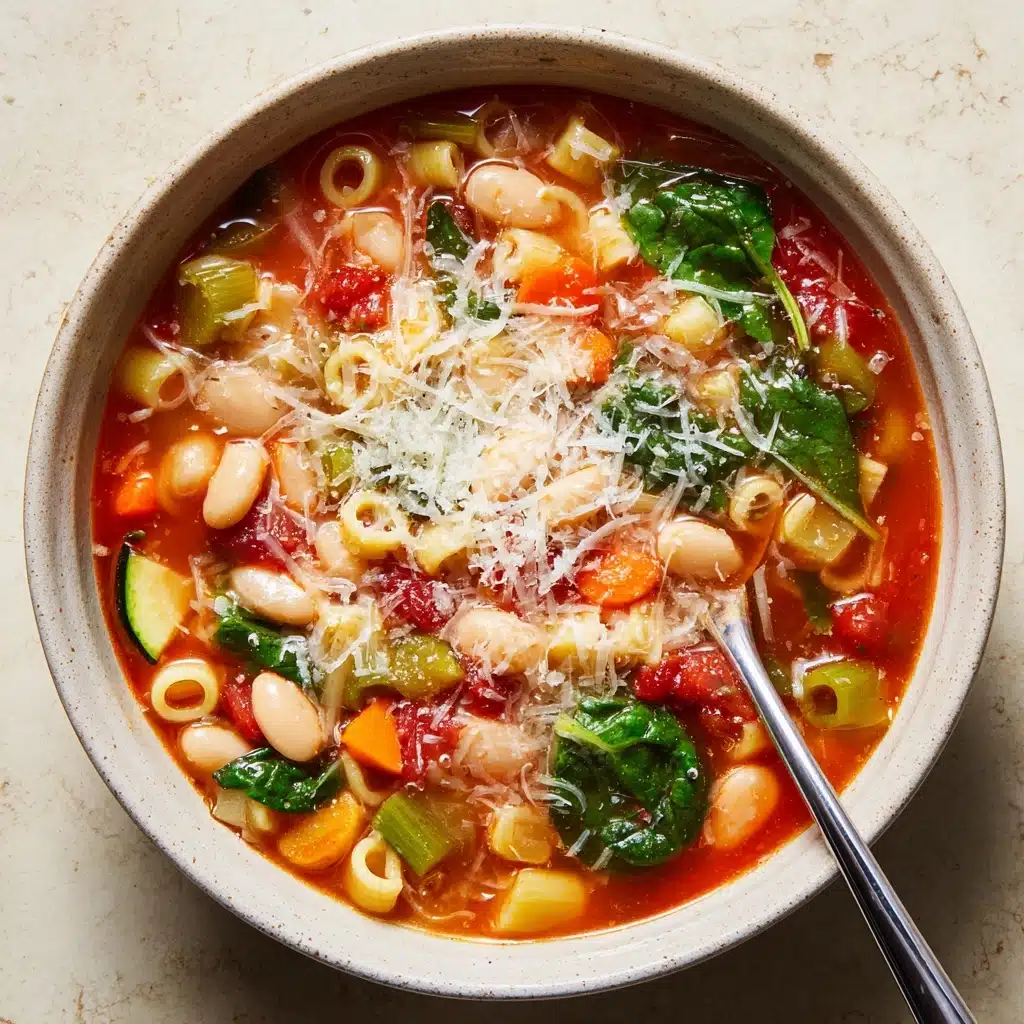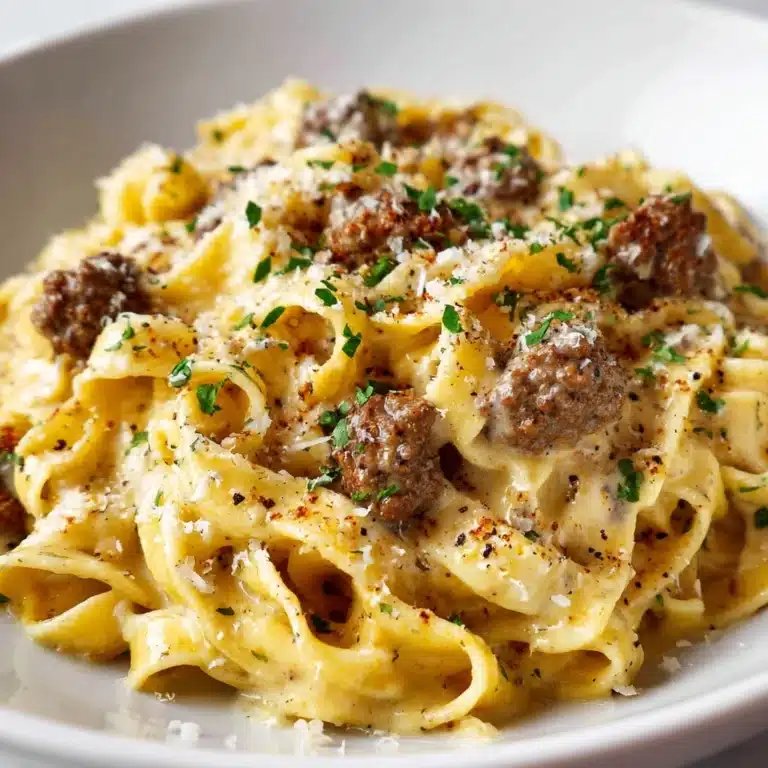If comfort could be ladled from a pot, it would look and taste exactly like Minestrone Soup. This classic Italian favorite brims with a medley of vegetables, hearty beans, and just the right amount of pasta, all swirled together in a fragrant tomato broth. Warm, nourishing, and easy to tailor to your taste, Minestrone Soup brings vibrancy and coziness to even the busiest weeknight—and just wait until you try it with a shower of Parmesan on top!

Ingredients You’ll Need
The magic of Minestrone Soup is how simple ingredients turn into something utterly crave-worthy. Each element here isn’t just for show: every veggie, spice, and splash of olive oil infuses the soup with color, richness, and extra nutrition.
- Olive oil: Adds a luscious base and helps develop all the vegetable flavors.
- Yellow onion: Its gentle sweetness builds a wonderful foundation for the soup.
- Garlic cloves: A couple of cloves bring a deep, aromatic kick that sets the tone.
- Carrots: These orange gems provide a subtle sweetness and a pop of color.
- Celery stalks: Classic in Italian soups, celery adds crunch and earthiness.
- Zucchini: Absorbs flavors beautifully while staying tender yet firm.
- Russet potato: Adds heartiness and thickens the broth slightly as it cooks.
- Dried oregano: An herb that brings depth and a touch of the Mediterranean.
- Dried basil: For that unmistakable fresh, sweet Italian flavor.
- Dried thyme: A little goes a long way to create a savory backbone.
- Bay leaf: This lifts the aroma and rounds out the flavor profile.
- Canned diced tomatoes with juice: The juicy tomatoes are crucial for the soup’s tangy base.
- Vegetable broth: Keeps the soup vegetarian and unites all the flavors in a savory embrace.
- Red kidney beans: These beans add a creamy bite and rich color.
- Cannellini beans: Offer tender texture that soaks up the broth’s flavor.
- Small pasta (like ditalini): Classic minestrone calls for bite-sized shapes that don’t overwhelm the spoon.
- Fresh spinach: Just tossed in at the end, it wilts perfectly and adds a garden-fresh color.
- Salt and pepper: To taste, tightening up all the other flavors.
- Grated Parmesan cheese (optional): For a rich, salty finish that melts into the hot soup.
How to Make Minestrone Soup
Step 1: Sauté the Aromatics
Begin by warming a tablespoon of olive oil in a large pot over medium heat. Add your diced onion and give it a few minutes to sweat until it turns translucent and soft. This gentle start is where all the flavor begins to build—don’t rush it! Once the onions are just right, stir in the minced garlic, then add carrots and celery. Let these cook for a few more minutes, allowing their sweetness and crispness to bloom.
Step 2: Layer in the Vegetables and Herbs
Time to add excitement: toss in the chopped zucchini, diced potato, and all the dried herbs—oregano, basil, thyme—plus the bay leaf. Stir everything together so the veggies are coated in the aromatic mixture. The kitchen will begin to smell incredible as the herbs awaken and mingle with the vegetables!
Step 3: Add Tomatoes and Broth
Pour in the can of diced tomatoes with their juice, followed by the vegetable broth. Stir well to make sure none of those tasty bits are sticking to the bottom. Crank up the heat, bring it all to a merry boil, then lower the heat and let it simmer for about 15 minutes. This is where the broth takes on all the personality of the veggies and herbs.
Step 4: Beans and Pasta Join the Party
Once the soup has bubbled and the potatoes have started to soften, dump in the kidney beans, cannellini beans, and your small pasta. Let these simmer along for another 10 to 12 minutes, just until the pasta and veggies are tender (don’t forget to stir now and then so nothing sticks!).
Step 5: Finishing Touches
With just a couple minutes to go, stir in the fresh chopped spinach. It wilts beautifully and adds a splash of vibrant green just before serving. Taste and season with salt and pepper to your liking, then fish out the bay leaf—nobody wants to bite into that! Ladle into bowls and top with grated Parmesan cheese if you love that extra savory, melty finish.
How to Serve Minestrone Soup

Garnishes
A piping-hot bowl of Minestrone Soup is inviting on its own, but a handful of fresh garnishes makes it irresistible. Try a flourish of grated Parmesan (the classic!), a shower of chopped parsley, or a drizzle of good olive oil. If you love a bit of heat, sprinkle on red pepper flakes or grind some black pepper over the top.
Side Dishes
Minestrone Soup is filling, but it’s also fantastic paired with crusty bread—think a rustic ciabatta, sourdough, or garlic toast for dunking. For a lighter side, serve a crisp green salad dressed with a citrusy vinaigrette to perk up the palate. Even a platter of olives or a wedge of soft cheese can make a lovely Italian-inspired spread.
Creative Ways to Present
Give your Minestrone Soup a little bistro flair by serving it in wide, shallow bowls for a colorful veggie showcase. Add a Parmesan crisp on top for crunch, or offer “build-your-own” toppings like pesto, croutons, or dollops of ricotta. Hosting friends? Try pouring the soup into small mugs for a cozy starter at casual gatherings.
Make Ahead and Storage
Storing Leftovers
Any extra Minestrone Soup stores like a dream! Simply let the soup cool to room temperature, then transfer to airtight containers and refrigerate. It keeps perfectly for up to four days, and if anything, the flavors get even better after a night in the fridge.
Freezing
To freeze Minestrone Soup, cool it completely first. Ladle into freezer-safe containers (leave an inch of space at the top). If you plan to freeze, consider cooking the pasta separately and adding it fresh later—the texture holds up better this way. Frozen minestrone will stay tasty for up to three months.
Reheating
To reheat, pour the chilled or thawed Minestrone Soup into a pot and warm over medium heat, stirring now and then until piping hot. If the pasta has absorbed some broth, add a splash of water or extra stock to loosen it up. For single portions, the microwave works great—just cover and heat in short bursts, stirring between each one.
FAQs
Does Minestrone Soup have to include pasta?
Not at all! If you’re out of pasta or want a lighter option, simply leave it out—Minestrone Soup is still hearty thanks to the potatoes and beans. Or try swapping in rice or quinoa for a twist.
Can I add meat to Minestrone Soup?
Definitely. While this recipe is traditionally vegetarian, feel free to brown some Italian sausage or pancetta with the onion step for a meaty spin. Shredded chicken or turkey also makes a tasty, protein-packed addition.
Is Minestrone Soup gluten free?
The soup itself is easily made gluten free—just choose a gluten-free pasta or skip the pasta completely. Always check your broth and canned beans to be sure they don’t contain any hidden gluten.
What other vegetables can I use in Minestrone Soup?
This soup is a wonderful way to clean out the fridge! Toss in green beans, peas, bell peppers, or even cabbage. Swap in kale for spinach, or adjust the mix based on what’s in season to keep things fresh and exciting.
How do I make Minestrone Soup richer and heartier?
If you crave an even more substantial bowl, stir in a spoonful of tomato paste along with the tomatoes or add extra beans. For an ultra-rich finish, top each serving with a swirl of pesto or a pat of butter just before serving.
Final Thoughts
There’s a reason so many people adore Minestrone Soup—it’s bright, comforting, and endlessly customizable, whether you stick with the classics or make it your own. Give it a try, and you might just surprise yourself with how easy it is to create a pot brimming with flavor and goodness. The next time you crave a bowl of warmth and cheer, you know exactly what to make!
Print
Minestrone Soup Recipe
- Total Time: 45 minutes
- Yield: 6 servings 1x
- Diet: Vegetarian
Description
Warm up with a comforting bowl of homemade Minestrone Soup filled with hearty vegetables, beans, and pasta in a flavorful broth. This classic Italian soup is easy to make and perfect for a cozy meal.
Ingredients
Vegetable Base:
- 1 tablespoon olive oil
- 1 small yellow onion (diced)
- 2 garlic cloves (minced)
- 2 medium carrots (peeled and sliced)
- 2 celery stalks (sliced)
- 1 zucchini (chopped)
- 1 small russet potato (peeled and diced)
Seasonings and Broth:
- 1 teaspoon dried oregano
- 1 teaspoon dried basil
- ½ teaspoon dried thyme
- 1 bay leaf
- 1 (14.5-ounce) can diced tomatoes with juice
- 4 cups vegetable broth
Beans and Pasta:
- 1 (15-ounce) can red kidney beans (drained and rinsed)
- 1 (15-ounce) can cannellini beans (drained and rinsed)
- 1 cup small pasta (like ditalini)
Additional Ingredients:
- 2 cups chopped fresh spinach
- Salt and pepper to taste
- Grated Parmesan cheese for serving (optional)
Instructions
- Prepare Vegetable Base: Heat olive oil in a large pot. Add onion, cook until softened. Stir in garlic, carrots, and celery; cook for 5 minutes.
- Add Seasonings and Broth: Add zucchini, potato, oregano, basil, thyme, bay leaf, tomatoes, and broth. Simmer for 15 minutes.
- Include Beans and Pasta: Add kidney beans, cannellini beans, and pasta. Simmer for 10-12 minutes until tender.
- Finish Soup: Stir in spinach, cook for 2 minutes. Season with salt and pepper. Remove bay leaf before serving. Serve hot with Parmesan cheese.
Notes
- You can substitute kale for spinach or use other vegetables like green beans or peas.
- For a gluten-free version, use gluten-free pasta.
- Prep Time: 15 minutes
- Cook Time: 30 minutes
- Category: Main Course
- Method: Stovetop
- Cuisine: Italian
Nutrition
- Serving Size: 1 bowl
- Calories: 290
- Sugar: 6g
- Sodium: 540mg
- Fat: 6g
- Saturated Fat: 1g
- Unsaturated Fat: 4.5g
- Trans Fat: 0g
- Carbohydrates: 45g
- Fiber: 10g
- Protein: 12g
- Cholesterol: 0mg







